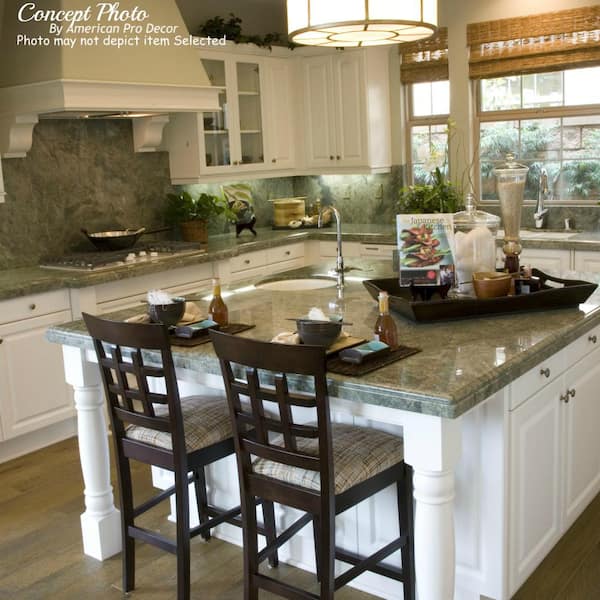Important Elements to Consider When Picking Legs For Cooking Area Island
Choosing the appropriate legs for a cooking area island involves a careful evaluation of multiple factors that can dramatically affect both capability and aesthetic charm. As we discover these aspects, it ends up being clear that each decision can have far-reaching effects for the total kitchen area experience.
Product Options
When selecting legs for a kitchen island, comprehending the numerous product choices is essential for achieving both aesthetic charm and structural stability (Legs For Kitchen Island). The option of material considerably influences not only the sturdiness of the island yet additionally its total layout and functionality
Steel legs, commonly made from stainless steel or functioned iron, add a industrial and contemporary feel while ensuring sturdiness and stability. These products are immune to use and can sustain considerable weight, making them perfect for larger islands.
Another choice is engineered products, like MDF or plywood, which can be extra economical while still supplying a series of surfaces. Nonetheless, they might not offer the exact same level of security as strong timber or steel. Finally, products such as acrylic or glass can produce a modern appearance, though they may call for extra assistance to make certain stability.
Inevitably, the choice of material for cooking area island legs need to align with the preferred capability and the total style of the kitchen area.
Design and Layout

When thinking about style, the form and coating of the legs are important. Conical legs can give a sense of agility and beauty, while thicker, much more robust legs can communicate strength and stability. In addition, the finish-- be it painted, stained, or all-natural-- must enhance the kitchen cabinetry and countertop materials to develop a unified look.
Moreover, the layout of the legs can likewise show individual preference. Custom-made or decorative legs, such as those featuring intricate carvings or distinct geometric shapes, can function as prime focus, adding personality and individuality to the cooking area. Inevitably, the right option will not only improve capability however likewise elevate the aesthetic charm, making the kitchen island a standout attribute of the home.
Height Considerations
Choosing the appropriate height for kitchen island legs is crucial, as it straight impacts both capability and comfort. The basic height for a cooking area island generally varies from 36 to 42 inches, lining Get the facts up with common countertop heights.

It is likewise important to make up customers' elevations and choices. Customizing the height can ensure a comfy experience for all household members, making the kitchen area island an extra delightful and practical space.
Weight Assistance
Guaranteeing ample weight support for kitchen area island legs is essential for both security and capability. The kitchen island commonly serves multiple objectives, consisting of cooking, eating, and additional storage space, necessitating a robust support framework. When choosing legs, it is essential to consider the total weight ability called content for based upon the island's meant usage and the materials that will certainly be put on it.
The choice of material for the legs plays a substantial duty in their weight-bearing capacities. Strong wood, steel, and durable compounds generally provide remarkable stamina compared to lighter materials. Additionally, the layout of the legs-- whether they are straight, tapered, or have a pedestal form-- can influence their ability to disperse weight properly across the framework.
Constantly consult the manufacturer's specs pertaining to tons limits to guarantee that the legs can maintain the desired weight without compromising safety and security. In recap, choosing cooking area island legs with sufficient weight assistance is necessary for producing a safe and functional culinary area.
Installation and Maintenance
Appropriate installation and upkeep of kitchen area island legs are crucial for ensuring durability and stability. This usually involves securing the legs to the island base making use of suitable fasteners, ensuring that the legs are degree and aligned.
Once installed, routine maintenance is necessary to protect the honesty and appearance of the legs - Legs For Kitchen Island. For wood legs, regular cleaning with a moist towel and application of ideal wood polish can avoid dampness damage and keep their surface. Steel legs may require a gentle cleansing solution to get rid of grease and crud, adhered to by a completely dry towel to avoid rust formation
Additionally, inspect the legs on a regular basis for indicators of wear or damage, such as fractures or loose joints. Tightening screws or screws as required can likewise prolong the lifespan of the legs. By adhering to these setup and maintenance techniques, house owners can guarantee that their kitchen area island stays durable and visually appealing for many years to come.
Conclusion

Visual comprehensibility is paramount in selecting the style and design of legs for a kitchen island, as these elements substantially influence the general setting of the space. Conical legs can provide a sense of lightness and sophistication, while thicker, more durable legs can share stamina and stability.Picking the ideal elevation for kitchen area island legs is important, as it directly affects both capability and convenience. In recap, choosing kitchen area island legs with sufficient weight assistance is important for creating a risk-free and practical cooking area.
In verdict, choosing why not try these out legs for a kitchen area island necessitates careful consideration of numerous aspects, including product choices, style, elevation, weight support, and installment.